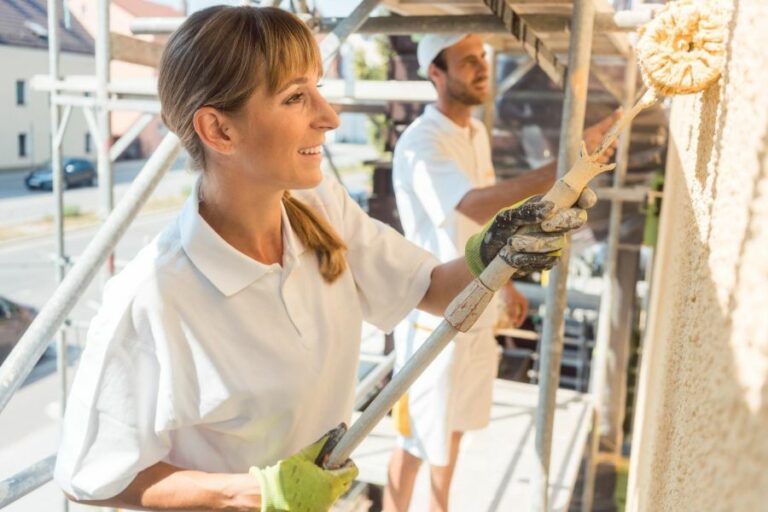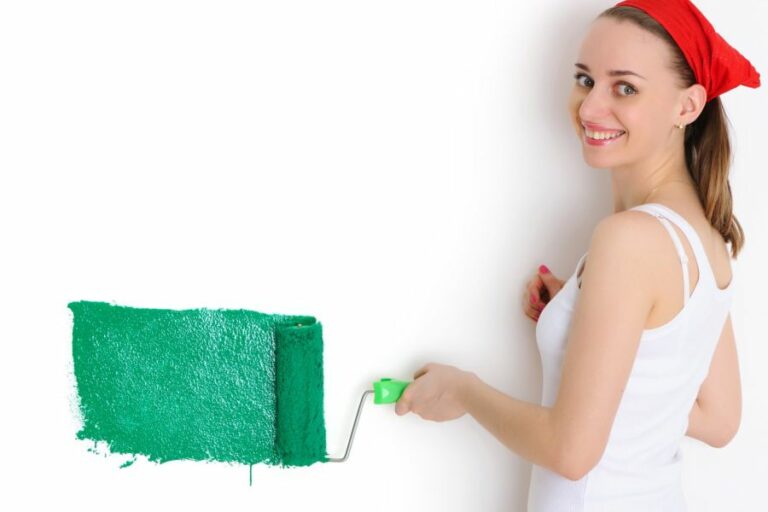Water-Resistant Acrylic Wall Paint
Are you tired of moisture problems and water stains on your interior walls? The water-resistant acrylic wall paint might be the perfect solution you’ve been searching for. I’m excited to share this fantastic product and its benefits and uses.
Water-resistant acrylic wall paint:
Water-resistant acrylic wall paint is a durable, low VOC, and easy-to-apply paint that protects against moisture-related damages such as mold, mildew, and peeling. Ideal for use in bathrooms, kitchens, basements, garages, and exterior walls, this paint offers a long-lasting, flexible finish that resists cracking and peeling while being easy to clean and maintain. Regular cleaning, timely repairs, and minimizing excessive moisture exposure enhance its performance and longevity.

Looking to give your walls a fresh new look that can withstand everyday mishaps? Discover the world of water-resistant acrylic wall paint – a durable and stylish solution. Read on to learn more about its benefits, best practices for application, and how it can spruce up your space!
Contents
- 1 Acrylic Wall Paint with Water Resistance
- 2 Acrylic Wall Paint: Waterproof or Not?
- 3 Water-Resistant Acrylic Paint Characteristics
- 4 Waterproof Paint Options for Walls
- 5 Acrylic Paint’s Waterproof Qualities
Acrylic Wall Paint with Water Resistance
Undoubtedly, wall paint plays a crucial role in enhancing the aesthetic appeal of our living spaces. However, the advantages of using high-quality wall paint extend beyond their visual appearance.
One such beneficial product is water-resistant acrylic wall paint, which offers an excellent solution for protecting walls from moisture-related damage.
• Understanding Water Resistant Acrylic Wall Paint
Water-resistant acrylic wall paint is a type of paint formulated to provide a sturdy and long-lasting finish resistant to water infiltration. This paint prevents the absorption of moisture into the surface, thus safeguarding walls from potential damages such as mold, mildew, and peeling.
– Advantages of Water Resistant Acrylic Wall Paint
- Durability: Acrylic wall paint is known for its durability, which makes it a preferred choice for high-traffic areas or damp environments prone to moisture exposure.
- Low VOC content: Acrylic paints emit a low amount of volatile organic compounds (VOCs), which minimizes their impact on indoor air quality.
- Easy application: Water-resistant acrylic wall paint can be applied using common painting tools like brushes, rollers, or sprays, making it user-friendly for both novice and experienced painters.
- Quick drying: The water-based composition allows acrylic wall paints to dry relatively faster compared to oil-based paints.
- Resistance to cracking and peeling: The flexible nature of acrylic paint ensures that it does not crack or peel easily, thereby preserving the appearance and integrity of painted surfaces.
- Easy maintenance: Acrylic wall paint can be easily cleaned with a damp cloth, soap, and water, allowing you to maintain the pristine look of your walls for an extended period.
• Ideal Applications for Water Resistant Acrylic Wall Paint
– Bathrooms and Kitchens
The humidity and moisture in bathrooms and kitchens make these areas highly susceptible to mold and mildew growth. Using water-resistant acrylic wall paint in these spaces provides an excellent defense against such issues while offering a durable, easy-to-clean surface.
– Basements and Garages
Basements and garages are often prone to damp conditions, making them ideal candidates for water-resistant acrylic wall paint. This paint not only protects against mold growth but also offers a durable finish that can withstand the wear and tear common in these spaces.
– Exterior Walls
It’s crucial to use water-resistant acrylic wall paint on exterior walls as it provides protection against harsh weather conditions like rain, snow, and UV radiation. The durability and water resistance of acrylic paint also prevent chipping, fading, and peeling, ensuring long-lasting curb appeal.
• Maintenance Tips for Water Resistant Acrylic Wall Paint
– Regular Cleaning
Routine cleaning is essential to maintain the appearance and performance of your water-resistant acrylic wall paint. Gently clean the surface with a damp cloth and mild soap, taking care not to damage the paint.
– Timely Repairs
Inspect your walls periodically for signs of damage or wear, such as cracks or peeling paint. Address these issues promptly to preserve the paint’s water-resistant properties and overall appearance.
– Avoid Excessive Moisture Exposure
While water-resistant acrylic wall paint offers excellent protection against moisture, it is essential to minimize exposure to excessive water. Install proper ventilation systems in damp areas like bathrooms and kitchens, and address any leaks or water seepage immediately.
• Expert Recommendations
I recommend using a high-quality primer before applying water-resistant acrylic wall paint, as it enhances the paint’s adhesion to the surface, improving its water resistance and durability. Additionally, opt for reputable paint brands to ensure maximum performance and longevity.
Remember, while water-resistant acrylic wall paint is an excellent solution for areas prone to moisture, it is not a substitute for addressing underlying structural issues that may be causing water seepage or excessive humidity.
For more information on water-resistant acrylic wall paint and its proper application, visit EPA’s Guide on Painting, which offers valuable insights into selecting and using paints in a safe and responsible manner.
Acrylic Wall Paint: Waterproof or Not?
When it comes to painting your walls, acrylic paint is one of the most popular choices due to its versatility and durability. However, many people wonder whether this type of paint is waterproof.
• Understanding Acrylic Paint
Acrylic paint is a water-based paint made of pigment particles dispersed in an acrylic polymer emulsion. It is known for its quick drying time, ease of use, and compatibility with different surfaces. It also offers excellent adhesion and flexibility, making it suitable for interior and exterior painting projects.
– Water Resistance of Acrylic Paint
While acrylic paint is not completely waterproof, it does provide a certain degree of water resistance. The paint dries to form a solid, flexible layer that can withstand exposure to moisture and humidity. As a result, acrylic paint is suitable for use in areas with high humidity, such as bathrooms or kitchens.
However, it is essential to understand that acrylic paint alone cannot provide complete waterproofing for your walls. If you expect your walls to be exposed to direct or prolonged contact with water, you must take additional steps to ensure adequate waterproofing.
• Effective Waterproofing Techniques for Acrylic Painted Walls
To enhance the waterproofing capabilities of acrylic paint, consider implementing the following steps and measures:
– Surface Preparation
Proper surface preparation significantly impacts the paint’s waterproofing performance. Ensure that your walls are clean, dry, and free from any mold, mildew, or loose debris. You can use a mold and mildew remover approved by the Environmental Protection Agency (EPA) to address any problematic areas.
Additionally, repairing any cracks or gaps in the walls with a suitable filler or sealant will further improve waterproofing capabilities.
– Primer Application
Applying a primer before the acrylic paint can improve adhesion, reduce the number of paint layers required, and enhance the paint’s water resistance. Choose a water-resistant primer specifically designed for use with acrylic paints, and make sure to follow the manufacturer’s guidelines for application.
– Waterproofing Additives
Some manufacturers produce additives that can be mixed with acrylic paint to improve its water resistance. These additives provide an additional layer of protection against water without changing the paint’s color or finish.
Make sure to follow the instructions and recommended mixing ratios provided by the manufacturer.
– Sealant Application
After the acrylic paint has dried, applying a sealant or clear coat can further enhance its water resistance. These products form a protective barrier on top of the paint, providing an additional shield against water ingress.
Select a sealant or clear coat that is specifically designed for use with acrylic paints and can withstand the particular conditions of your space.
• Recommendations for Acrylic Painted Walls in Wet Areas
If you would like to use acrylic paint in a high-moisture area, such as a bathroom, kitchen, or laundry room, consider the following recommendations:
- Choose a paint that is specifically formulated for use in high-humidity areas. These paints typically contain mold and mildew inhibitors and are designed to resist the growth of harmful organisms.
- Apply the paint in multiple layers to ensure better coverage and improved water resistance.
- Regularly inspect and maintain your painted walls, addressing any potential issues to prevent water ingress and damage.
• Conclusion
In summary, while acrylic paint is not completely waterproof, it does offer a certain degree of water resistance suitable for use in humid areas when applied correctly.
To enhance its waterproofing capabilities, properly prepare the surface, apply a suitable primer, consider using waterproofing additives, and seal the paint with a compatible sealant or clear coat.
Regular inspections and maintenance are also crucial in ensuring long-lasting protection for your acrylic-painted walls.
Water-Resistant Acrylic Paint Characteristics
Acrylic paints are a popular form of art supplies, often chosen for their versatility and fast-drying properties. A common question asked by beginners and professional artists alike is whether these paints are water resistant.
The answer to this question lies in understanding the composition of acrylic paints and the factors that influence their water resistance.
• The Composition of Acrylic Paints
Acrylic paints are made from a combination of pigments, water, and acrylic polymer emulsion. The acrylic polymer acts as a binding agent, holding the pigment particles together and adhering to your painting surface.
– How Acrylic Paints Dry
When you apply acrylic paint to a surface, the water in the mixture begins to evaporate. As the water content reduces, the acrylic polymer particles get closer together and eventually fuse. This process forms a solid, water-resistant film, which encapsulates the pigment particles and holds them in place.
• Factors Affecting the Water Resistance of Acrylic Paints
Though acrylic paints are inherently water-resistant when dry, various factors can impact their overall water resistance.
– Quality of Paints
Not all acrylic paints are created equal. High-quality, professional-grade acrylic paints offer better water resistance than cheaper, student-grade alternatives. Premium acrylics have a higher pigment concentration and better-quality acrylic polymer binders, contributing to a superior water-resistant finish.
I recommend investing in the highest quality paints you can afford to ensure optimal water resistance and vibrancy of your artwork.
– Thickness of Paint Application
The thickness of your paint application can directly affect the water resistance of your acrylic paints. Thicker paint layers take longer to dry and require more time for the acrylic polymer to form a water-resistant film.
Additionally, if the paint does not form a uniform film due to unevenly applied layers, it may be more vulnerable to water exposure.
– Surface Preparation
Properly preparing your painting surface can also play a crucial role in the overall water resistance of acrylic paintings. For example, using a high-quality gesso or primer can provide a more stable, water-resistant base to which the acrylic paint can adhere better.
– Environmental Factors
Humidity, temperature, and air circulation can significantly impact acrylic paints’ drying time and overall water resistance. Ensure you work in a well-ventilated space with controlled temperature and humidity.
• Protecting Your Acrylic Paintings for Increased Water Resistance
To further enhance the water resistance of your acrylic paints, you can take additional precautions, such as sealing your artwork with a protective varnish. First, wait for your painting to be entirely dry, then apply a suitable varnish to help shield your artwork from water damage and provide UV protection.
Several varnish types are commonly used for acrylic paintings, including:
- Gloss Varnish: This type of varnish provides a shiny finish and enhances the vibrancy of the colors in your artwork. It may require several coats for optimal protection.
- Matte Varnish: A matte varnish offers a non-reflective, subtle finish that doesn’t alter the appearance of your artwork. It is ideal for detail-oriented pieces where shiny surfaces can be distracting.
- Satin Varnish: Satin varnish combines the best of both worlds, giving your painting a soft and gentle sheen without being too shiny or too flat.
To ensure the varnish you use is compatible with your acrylic paints, it’s recommended to stick with the same brand, as the manufacturer will have designed their varnishes to work in harmony with their paint offerings.
• In Conclusion
In summary, acrylic paints are water resistant once fully dry, but this water resistance can be affected by various factors, such as the quality of the paints, the thickness of the paint application, surface preparation, and environmental factors.
Protecting your acrylic paintings with a suitable varnish can further enhance their water resistance, ensuring your artwork remains vibrant and safe from water damage.
For more information on working with acrylic paints, the Golden Artist Colors website offers a wealth of resources and educational materials.
Waterproof Paint Options for Walls
Waterproofing is a crucial process for protecting the structural integrity of your building, ensuring longevity, and avoiding costly repairs. One of the common queries is whether waterproof paint for walls is actually available and effective.
• Understanding Waterproof Paints
Waterproof paints, as the name suggests, are designed to provide a protective barrier against water ingress, dampness, and moisture for walls.
These paints are made with special additives and materials, such as latex or silicone, that impart water-resistant properties, thereby reducing the impact of environmental factors on your walls.
- Latex-based Waterproof Paints: These paints are made using water-soluble synthetic polymers and offer excellent adhesion to various surfaces. They are easy to work with, dry quickly, and can be cleaned with soap and water.
- Silicone-based Waterproof Paints: Silicone-based paints are more resistant to water and weather conditions than latex-based materials. They provide a durable and flexible protective layer that can withstand extreme temperatures and prevent damage caused by ultraviolet (UV) radiation exposure.
While waterproof paints can play a vital role in keeping your walls dry and moisture-free, it’s essential to understand that they are not a one-stop solution for all waterproofing needs. They work great as a supplementary measure alongside other waterproofing techniques and materials for optimum results.
• Preparing Walls for Waterproof Paint Application
Achieving the perfect waterproof finish begins with proper surface preparation. To ensure maximum adhesion and effectiveness of waterproof paint, follow the steps below:
- Inspect and clean: Inspect the walls for any signs of damage, such as cracks, peeling paint, or mold. Clean the surface thoroughly and remove any loose debris or contaminants. For moldy walls, use a mold-killing solution and scrub the area vigorously before rinsing with water.
- Repair: Fill any cracks or holes with a suitable filler, and sand the surface to ensure evenness. You may need to apply a primer to enhance the adherence to the waterproof paint.
- Dry: Allow the wall to dry completely before proceeding with the paint application. This is critical to achieving an effective waterproof coat.
- Tape: Use painter’s tape to protect any surfaces that you don’t want to paint, such as windows, doors, or trim.
• Applying Waterproof Paint – Best Practices
Applying waterproof paint requires careful planning and execution. Consider the following tips for getting the best results:
- Choose the right paint: Select a high-quality waterproof paint that is well-suited for your application. Look for products with mildew-resistant properties, UV protection, and long-lasting durability.
- Apply multiple coats: Applying multiple coats of waterproof paint ensures optimal protection. Allow adequate drying time between coats according to the manufacturer’s instructions.
- Use the right tools: Invest in high-quality brushes, rollers, or sprayers specifically designed for waterproof paint application. Proper tools help you achieve an even and consistent finish.
- Temperature and weather conditions: The EPA website recommends applying waterproof paint in temperatures ranging from 50-90F (10-32C) and avoiding extreme humidity or direct sunlight.
• Advantages and Limitations of Waterproof Paints
– Advantages
- Aesthetic appeal: Waterproof paints are available in a wide range of colors and finishes, enhancing the overall aesthetic appeal of your walls.
- Mold and mildew resistance: High-quality waterproof paints offer resistance to mold and mildew, thereby maintaining a healthy living environment.
- Easy maintenance: Waterproof painted walls are easy to clean and maintain, as they can be wiped down without damage to the paint.
– Limitations
- Not a comprehensive solution: Waterproof paint is not a complete solution for waterproofing your walls. It may not be suitable for walls with excessive water damage or where structural repairs are needed.
- Limited lifespan: Waterproof paint eventually degrades due to wear and tear, necessitating regular maintenance and reapplication.
• Wrapping Up – Is There Waterproof Paint for Walls?
Yes, waterproof paint for walls exists and can provide a valuable layer of protection against water ingress, dampness, and moisture.
However, it should not be considered a complete waterproofing solution. Instead, it should be used alongside other waterproofing techniques, such as proper drainage and sealants, to ensure maximum effectiveness.
Always research and choose high-quality waterproof paints for your walls, and follow the correct preparation and application methods to achieve the best long-lasting results.
Acrylic Paint’s Waterproof Qualities
Acrylic paint, a popular choice among artists and DIY enthusiasts, is known for its versatility, vibrant colors, and quick drying time. A common question asked by many is whether acrylic paint becomes waterproof after it dries.
• The Composition of Acrylic Paint
To understand the waterproof nature of acrylic paint, it is essential to know its composition. Acrylic paint is made up of pigments suspended in an acrylic polymer emulsion. This polymer is water-soluble, which means that when the paint is wet, it can be easily thinned using water.
However, once the acrylic paint dries, the water evaporates, and the polymer hardens, creating a water-resistant barrier around the pigments.
• Water Resistance vs. Waterproof
To accurately address the question of whether acrylic paint is waterproof after it dries, it is crucial to differentiate between water resistance and waterproof properties.
Water resistance implies that a material can resist water penetration to a certain extent but not entirely. Waterproof, on the other hand, means that the material is impervious to water and can completely prevent water penetration.
When acrylic paint dries, it becomes water-resistant but not entirely waterproof. This means that although it can resist small amounts of water and moisture, prolonged exposure to water can cause the paint to lift, become cloudy, or even lose adhesion.
• Factors Influencing the Water Resistance of Acrylic Paint
Several factors can affect the degree of water resistance that acrylic paint possesses once it dries. These factors include the quality of the paint, the surface it is applied on, and the environment.
– Quality of Acrylic Paint
The quality of acrylic paint greatly influences its water-resistance after drying. High-quality, artist-grade acrylic paints usually have a higher concentration of acrylic polymer, which enhances their water-resistant properties.
On the other hand, student-grade or low-quality acrylic paints often contain less acrylic polymer, reducing their water resistance capabilities.
– Surface
Before applying acrylic paint, it is essential to prepare the surface properly to ensure good adhesion and water resistance.
Surfaces should be clean, dry, and free of any contaminants, such as oil, dirt, or grease. Using a primer or gesso on porous surfaces like wood, canvas, or paper can help improve adhesion and water resistance.
Non-porous surfaces, like plastic or metal, require the use of special primers designed for these materials.
– Environment
The environment in which the acrylic paint is applied and stored also plays a crucial role in determining its water resistance. High humidity and fluctuating temperatures can negatively impact the paint’s adhesion and water resistance over time.
It is recommended to apply acrylic paint in a well-ventilated area at room temperature and store the painted object in a stable, moisture-free environment.
• Enhancing the Waterproof Properties of Acrylic Paint
While it is true that acrylic paint is not entirely waterproof after it dries, certain measures can be taken to improve its waterproof properties and durability.
– Varnishing
Applying a varnish over the dried acrylic paint creates an additional protective barrier that can enhance its resistance to water, UV rays, and wear. There are various types of varnishes available, including matte, satin, and gloss finishes.
When selecting a varnish, be sure to choose one that is compatible with acrylic paint and follow the manufacturer’s instructions for the best results.
– Sealants
Using a sealant in conjunction with acrylic paint can protect the paint against water damage more effectively. Sealants are available in spray or brush-on formats and can be found in various sheens, such as gloss or matte.
It is crucial to select a sealant specifically designed for use with acrylic paint and ensure that the painted surface is clean and dry before application.
• Conclusion
To sum up, acrylic paint dries to a water-resistant finish but is not entirely waterproof. Factors such as the paint’s quality, surface preparation, and environmental conditions can influence the paint’s water resistance.
To enhance the waterproof properties of acrylic paint, it is recommended to apply a suitable varnish or sealant. By understanding the limitations and characteristics of acrylic paint, artists and DIY enthusiasts can make informed choices and take the necessary steps to protect their creations from water damage.
For more information on acrylic paint and its properties, visit the National Gallery of Art’s website.







